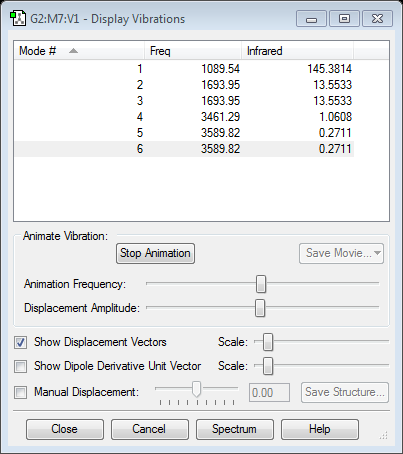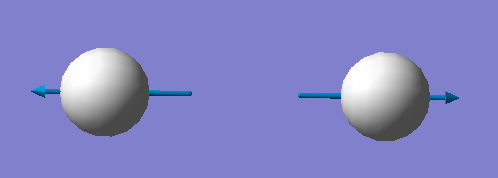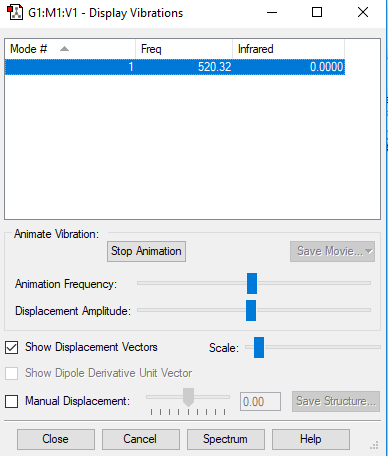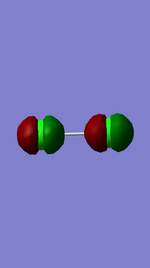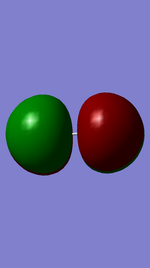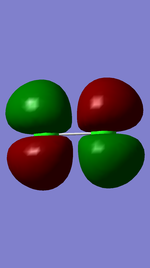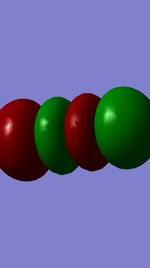01503930
Ammonia
Item Value Threshold Converged? Maximum Force 0.000006 0.000450 YES RMS Force 0.000004 0.000300 YES Maximum Displacement 0.000014 0.001800 YES RMS Displacement 0.000009 0.001200 YES Predicted change in Energy=-1.141616D-10 Optimization completed. -- Stationary point found.
Basic information
molecule name: ammonia
calculation method: RB3LYP
basis set: 6-31G(d,p)
final energy: -56.55777 a.u.
RMS gradient norm: 0.00000589 a.u.
point group: C3V
optimised N-H bond length: 1.02Å (bond lengths accurate to 0.01Å)
optimised H-N-H bond angle: 106° (bond angles accurate to ≈ 1°)
test molecule |
The optimisation file is liked to here
Information about the vibrations
The following image is the summary table of the vibrational states of the optimised ammonia:
1 2 3 4 5 6 symmetry A1 E E A1 E E wavenumber/cm-1 1089 1694 1694 3461 3590 3590 intensity 145 14 14 1 0 0
Answer to questions
6 vibrational modes are expected from the 3N-6 rule.
Mode 2&3, 5&6 are degenerate, which means they have the same energy.
Vibrations 1,2 and 3 are "bending" and vibrations 4,5,6 are "bond stretching".
Mode 4 is highly symmetrical.
Mode 1 is the umbrella mode.
Two bands are expected to be seen in an experimental spectrum of gaseous ammonia. It is because that mode 2&3, 5&6 are degenerate, and also mode 4,5 and 6 have very low intensities, which means they cannot be seen from the spectrum.
Charge Analysis
The charge on the N atom is -1.125, and that on the H atoms is 3.375. A negative charge is expected on nitrogen because it is very electronegative compared to hydrogen, so it pulls the charge towards itself.
N2
Item Value Threshold Converged? Maximum Force 0.000001 0.000450 YES RMS Force 0.000001 0.000300 YES Maximum Displacement 0.000000 0.001800 YES RMS Displacement 0.000000 0.001200 YES Predicted change in Energy=-3.400924D-13 Optimization completed. -- Stationary point found.
Basic information
molecule name: dinitrogen
calculation method: RB3LYP
basis set: 6-31G(d,p)
final energy: -109.52359 a.u.
RMS gradient norm: 0.0000006 a.u.
point group: D*H
optimised N-N bond length: 1.11Å (bond lengths accurate to 0.01Å)
test molecule |
The optimisation file is liked to here
Information about the vibrations
The following image is the summary table of the vibrational states of the optimised nitrogen:
1 Symmetry SGG Wavenumber/cm-1 2457 Intensity 0
Only one vibrational mode is seen and it is the "bond stretch" vibration.
Charge Analysis
There is no charge on either of the nitrogen atom as it is a symmetrical molecule and the dipoles cancel out.
Structure and Reactivity
link of VECWUY https://www.ccdc.cam.ac.uk/structures/Search?Ccdcid=VECWUY&DatabaseToSearch=Published
The structure VECWUY is found as a mono-metallic TM complex that coordinates N2. The N-N bond length in the structure is found to be 1.077Å, which is shorter than the computational distance. It is because the nitrogen is in gaseous state when it is not bonded, and in VECWUY it is in a different chemical environment and is bonded to different atoms in the complex. As the bond is shorter, it means that a stronger bond is present in the crystal structure. It might be due to the reason that the nitrogen pulls the electron density towards itself, which shortens the bond length and gives rise to a stronger interaction with the TM complex.
H2
Item Value Threshold Converged? Maximum Force 0.000000 0.000450 YES RMS Force 0.000000 0.000300 YES Maximum Displacement 0.000000 0.001800 YES RMS Displacement 0.000001 0.001200 YES Predicted change in Energy=-1.164079D-13 Optimization completed. -- Stationary point found.
Basic information
molecule name: dihydrogen
calculation method: RB3LYP
basis set: 6-31G(d,p)
final energy: -1.17854 a.u.
RMS gradient norm: 0.00000017 a.u.
point group: D*H
optimised H-H bond length: 0.74Å (bond lengths accurate to 0.01Å)
test molecule |
The optimisation file is liked to here
Information about the vibrations
The following image is the summary table of the vibrational states of the optimised hydrogen:
1 Symmetry SGG Wavenumber/cm-1 4466 Intensity 0
Only one vibrational mode is seen and it is the "bond stretch" vibration.
Charge Analysis
There is no charge on either of the hydrogen atom as it is a symmetrical molecule and the dipoles cancel out.
Energy calculations
E(NH3)= -56.55776873 a.u.
2*E(NH3)= -113.1155375 a.u.
E(N2)= -109.52359111 a.u.
E(H2)= : -1.17853936 a.u.
3*E(H2)= -3.53561808 a.u.
ΔE=2*E(NH3)-[E(N2)+3*E(H2)]= -0.05632831 a.u.= -147.9 kJ/mol
The product formed is more thermodynamically stable than the reactants because the ΔE is negative.
Cl2
Item Value Threshold Converged? Maximum Force 0.000043 0.000450 YES RMS Force 0.000043 0.000300 YES Maximum Displacement 0.000121 0.001800 YES RMS Displacement 0.000172 0.001200 YES Predicted change in Energy=-5.277141D-09 Optimization completed. -- Stationary point found.
Basic information
molecule name: dichlorine
calculation method: RB3LYP
basis set: 6-31G(d,p)
final energy: -920.34988 a.u.
RMS gradient norm: 0.0000251
point group: D*H
optimised Cl-Cl bond length: 2.04Å (bond lengths accurate to 0.01Å)
test molecule |
The optimisation file is liked to here
Information about the vibrations
The following image is the summary table of the vibrational states of the optimised chlorine:
1 Symmetry SGG Wavenumber/cm-1 520 Intensity 0
Only one vibrational mode is seen and it is the "bond stretch" vibration.
Charge Analysis
There is no charge on either of the chlorine atom as it is a symmetrical molecule and the dipoles cancel out.
MOs Analysis
The electronic configuration of chlorine is 1s2 2s2 2p6 3s2 3p5. It has 18 bonding electrons and 16 antibonding electrons. Following are the snapshots and analysis of 5 MOs of chlorine.
This MO is non-bonding and made up by 2s atomic orbitals. It is low in energy (-9.51828 a.u.) and is occupied.
This picture shows the non-bonding orbital of chlorine. 2pz contributes to this MO, forming a sigma bond. The MO is also low in energy (-7.28592 a.u.) and it's occupied.
The picture illustrates the antibonding MO. 3px contributes to the MO, forming a pi bond. This MO has an energy of -0.31361 a.u. and it's occupied.
This picture indicates the HOMO of chlorine and has an energy of -0.31361 a.u.. It is made up by the overlap of 3py atomic orbitals and is degenerate with the MO above. It's a HOMO, which means it is occupied.
This picture shows the LUMO of chlorine and has an energy of -0.14206 a.u.. 3pz AOs contribute to this antibonding MO. It's a LUMO, by which it means it's unoccupied.
Marking
Note: All grades and comments are provisional and subjecct to change until your grades are officially returned via blackboard. Please do not contact anyone about anything to do with the marking of this lab until you have recieved your grade from blackboard.
Wiki structure and presentation 1/1
Is your wiki page clear and easy to follow, with consistent formatting?
YES
Do you effectively use tables, figures and subheadings to communicate your work?
YES
NH3 1/1
Have you completed the calculation and given a link to the file?
YES
Have you included summary and item tables in your wiki?
YES
Have you included a 3d jmol file or an image of the finished structure?
YES
Have you included the bond lengths and angles asked for?
YES
Have you included the “display vibrations” table?
YES
Have you added a table to your wiki listing the wavenumber and intensity of each vibration?
YES
Did you do the optional extra of adding images of the vibrations?
YES
Have you included answers to the questions about vibrations and charges in the lab script?
YES, however you did miss out explaining exactly why only 2 modes are seen in the vibrational section. You correctly stated that there are two sets of degenerate modes - this explains a spectrum with 4 peaks. However there are only 2 peaks visible as peaks 4, 5 and 6 are of too low an intensity to be visible.
N2 and H2 0.5/0.5
Have you completed the calculations and included all relevant information? (summary, item table, structural information, jmol image, vibrations and charges)
YES, you could have explained that the charges are 0 as the electronegativities are equal.
Crystal structure comparison 0.5/0.5
Have you included a link to a structure from the CCDC that includes a coordinated N2 or H2 molecule?
YES - however a mono-metallic complex was asked. You refer to a complex containing both Ti and Co!
Have you compared your optimised bond distance to the crystal structure bond distance?
YES
Haber-Bosch reaction energy calculation 1/1
Have you correctly calculated the energies asked for? ΔE=2*E(NH3)-[E(N2)+3*E(H2)]
YES
Have you reported your answers to the correct number of decimal places?
YES
Do your energies have the correct +/- sign?
YES
Have you answered the question, Identify which is more stable the gaseous reactants or the ammonia product?
YES
Your choice of small molecule 3/5
Have you completed the calculation and included all relevant information?
YES
Have you added information about MOs and charges on atoms?
You have done a good job of presenting this information, well done! You could have explained the charges using an electronegativity argument. You could have commented on the intensity of the calculated vibration. The second MO you are showing is bot contributing to a sigma-bond as the contributing Mos are not overlapping and interacting at all. The way you are showing the third displayed MO doesn't make clear it originates from p-Orbitals! It could be a combination of s-orbitals with non matching phases as well. As you quoted MOs 3 and 4 are degenerate. Therefore, there is no way to decide one of them being the HOMO.0.5
Independence 0/1
If you have finished everything else and have spare time in the lab you could: Check one of your results against the literature, or Do an extra calculation on another small molecule, or Do some deeper analysis on your results so far
NO - no independent work was identified

